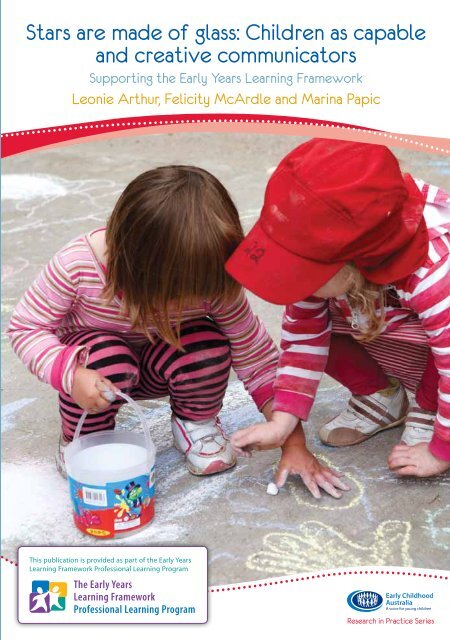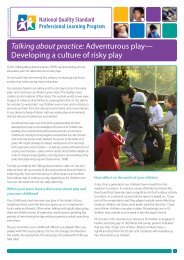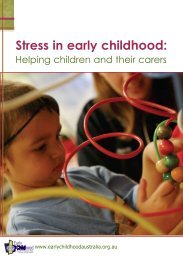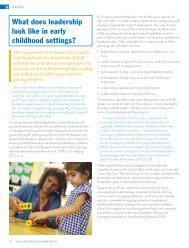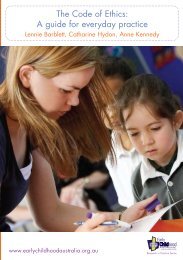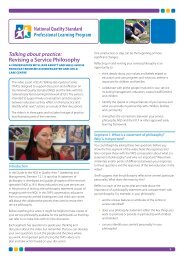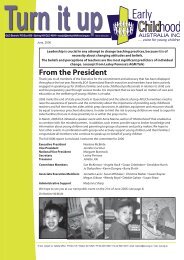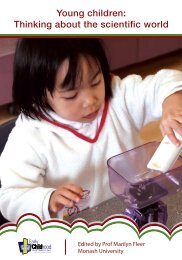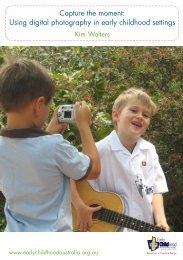Stars are made of glass - Early Childhood Australia
Stars are made of glass - Early Childhood Australia
Stars are made of glass - Early Childhood Australia
You also want an ePaper? Increase the reach of your titles
YUMPU automatically turns print PDFs into web optimized ePapers that Google loves.
<strong>Stars</strong> <strong>are</strong> <strong>made</strong> <strong>of</strong> <strong>glass</strong>: Children as capable<br />
and creative communicators<br />
Supporting the <strong>Early</strong> Years Learning Framework<br />
Leonie Arthur, Felicity McArdle and Marina Papic<br />
This publication is provided as part <strong>of</strong> the <strong>Early</strong> Years<br />
Learning Framework Pr<strong>of</strong>essional Learning Program<br />
Research in Practice Series
About <strong>Early</strong> <strong>Childhood</strong> <strong>Australia</strong><br />
<strong>Early</strong> <strong>Childhood</strong> <strong>Australia</strong> actively promotes<br />
the provision <strong>of</strong> high-quality services for all<br />
young children from birth to eight years and<br />
their families, and supports the important<br />
role <strong>of</strong> p<strong>are</strong>nts. <strong>Early</strong> <strong>Childhood</strong> <strong>Australia</strong> is<br />
also the national umbrella organisation<br />
for children’s services and a leading early<br />
childhood publisher.<br />
About the series<br />
The Research in Practice Series is<br />
published four times each year by<br />
<strong>Early</strong> <strong>Childhood</strong> <strong>Australia</strong>.<br />
The series aims to provide practical, easy to<br />
read, up-to-date information and support to a<br />
growing national readership <strong>of</strong> early childhood<br />
workers. The books bring together the best<br />
information available on wide-ranging topics and<br />
<strong>are</strong> an ideal resource for children’s services<br />
workers and others interested in the c<strong>are</strong> and<br />
education <strong>of</strong> young children.<br />
Series Editor Roslyn Mertin<br />
Edition Editor Jenni Connor<br />
Graphic Design Nathalie Scott<br />
Photographs Leonie Arthur, Felicity<br />
McArdle, Lynne Munsie,<br />
Marina Papic and<br />
Andrew Sikorski<br />
About the authors<br />
Invitation to authors<br />
If you <strong>are</strong> interested in writing for the<br />
Research in Practice Series or any other<br />
<strong>Early</strong> <strong>Childhood</strong> <strong>Australia</strong> publication,<br />
please contact the Publications Section<br />
for further information on the preparation <strong>of</strong><br />
manuscripts and for a copy <strong>of</strong> the guidelines<br />
for contributors.<br />
Membership, publishing<br />
and general enquiries<br />
<strong>Early</strong> <strong>Childhood</strong> <strong>Australia</strong> Inc.<br />
PO Box 86 Deakin West ACT 2600<br />
T: (02) 6242 1800<br />
F: (02) 6242 1818<br />
Sales line: 1800 356 900 (freecall)<br />
E: eca@earlychildhood.org.au<br />
publishing@earlychildhood.org.au<br />
© Copyright 2010<br />
All rights reserved by<br />
<strong>Early</strong> <strong>Childhood</strong> <strong>Australia</strong> Inc.<br />
Material herein must not be reproduced<br />
in any form without the written permission<br />
<strong>of</strong> <strong>Early</strong> <strong>Childhood</strong> <strong>Australia</strong> Inc.<br />
Registered for posting as a publication—<br />
PP232100/00036<br />
ISSN 1440-5148<br />
ISBN10 1-921162-42-2<br />
ISBN13 978-1-921162-42-8<br />
Printed by Elect Printing, Canberra<br />
Dr Leonie Arthur is a the Head <strong>of</strong> Program for <strong>Early</strong> <strong>Childhood</strong> and a senior lecturer at the<br />
University <strong>of</strong> Western Sydney. She lectures and is involved in research in the <strong>are</strong>as <strong>of</strong> early<br />
childhood curriculum and literacy learning and teaching.<br />
Associate Pr<strong>of</strong>essor Felicity McArdle lectures in the School <strong>of</strong> <strong>Early</strong> <strong>Childhood</strong>, at Queensland<br />
University <strong>of</strong> Technology. She teaches in the arts at undergraduate and postgraduate level, and is<br />
interested in the arts as ways <strong>of</strong> knowing for young children, as well as art as method for inquiry,<br />
and art and its connection with social justice issues.<br />
Dr Marina Papic is Head <strong>of</strong> the Institute <strong>of</strong> <strong>Early</strong> <strong>Childhood</strong>, Faculty <strong>of</strong> Human Sciences, Macquarie<br />
University. Her specialisations include mathematics education, early mathematics learning,<br />
curriculum and assessment, and patterning and early algebraic thinking.<br />
Leonie, Felicity and Marina were members <strong>of</strong> the consortium contracted to develop the <strong>Early</strong> Years<br />
Learning Framework, were critical friends to sites involved in the trial <strong>of</strong> the EYLF and continue to<br />
work closely with early childhood settings engaged in exploring the potential <strong>of</strong> the EYLF.
1 Introduction<br />
2 What does effective communication look like in the early years?<br />
3 What sorts <strong>of</strong> texts do children experience?<br />
4 How do children develop understandings <strong>of</strong> literacy in the early years?<br />
6 How do children develop understandings <strong>of</strong> numeracy in the early years?<br />
12 How do children express ideas and make meaning?<br />
17<br />
19<br />
What is the role <strong>of</strong> information and communication technologies in<br />
children’s communication?<br />
What is the role <strong>of</strong> the educator in documenting and analysing<br />
children’s communication?<br />
29 Conclusion<br />
30 Useful resources<br />
31 References<br />
Contents<br />
15 How do children get meaning from texts?<br />
21 How can educators plan for and scaffold children’s communication?<br />
<strong>Stars</strong> <strong>are</strong> <strong>made</strong> <strong>of</strong> <strong>glass</strong>: Children as capable and creative communicators<br />
i
1<br />
This booklet is the third in the Research in<br />
Practice Series, designed to complement<br />
Belonging, being & becoming: The <strong>Early</strong><br />
Years Learning Framework for <strong>Australia</strong><br />
Research in Practice Series Volume 18 Number 2 2010<br />
Introduction<br />
(DEEWR, 2009). It focuses on Learning<br />
Outcome 5 <strong>of</strong> the <strong>Early</strong> Years Learning<br />
Framework (EYLF): Children <strong>are</strong> effective<br />
communicators (DEEWR, 2009).
What does effective<br />
communication look like in<br />
the early years?<br />
Young children <strong>are</strong> curious and want<br />
to learn more about their worlds and<br />
their experiences. They <strong>are</strong> driven<br />
to communicate––first about their<br />
needs, and then about their desires,<br />
interests, knowledge and competencies.<br />
Communication—making and sharing<br />
meaning—is essential to learning, as<br />
well as to being and belonging.<br />
Children learn about their worlds and<br />
communicate with others using many<br />
different languages (Malaguzzi, 1998).<br />
Family, community and cultural practices<br />
all shape and influence children’s verbal<br />
and non-verbal languages, their patterns<br />
<strong>of</strong> interaction and their preferred modes <strong>of</strong><br />
communication. Through interactions with<br />
family, community members and educators,<br />
young children learn to use, understand<br />
and respect many ways <strong>of</strong> communicating.<br />
These may include drawing, constructing,<br />
composing music, and performing, as<br />
well as speaking, reading and writing in<br />
community languages and/or English.<br />
The arts (music, dance, drama, visual<br />
arts and media) provide powerful ways to<br />
communicate. Sometimes, the arts can be<br />
used to express ideas when words <strong>are</strong> not<br />
available, or <strong>are</strong> inadequate (Wright, 2003).<br />
At the same time, if the goals <strong>of</strong> equity and<br />
success for all children <strong>are</strong> to be achieved,<br />
children must be able to communicate their<br />
knowledge, experiences and ideas skilfully<br />
in the language used by those around them.<br />
This means they must learn to read<br />
and write. Educators play a critical role<br />
in supporting children to be effective<br />
communicators. The EYLF highlights the<br />
importance <strong>of</strong> intentional teaching, where<br />
educators <strong>are</strong> ‘deliberate, purposeful and<br />
thoughtful in their decisions and interactions’<br />
(DEEWR, 2009, p. 45). This is particularly<br />
important in the <strong>are</strong>a <strong>of</strong> communication,<br />
where well-planned play environments<br />
which <strong>are</strong> rich in language and opportunities<br />
to exchange meaning with others support<br />
children to develop understandings <strong>of</strong> texts<br />
and symbols. This process is also facilitated<br />
by educator modelling, co-construction<br />
and scaffolding.<br />
<strong>Stars</strong> <strong>are</strong> <strong>made</strong> <strong>of</strong> <strong>glass</strong>: Children as capable and creative communicators<br />
2
3<br />
What sorts <strong>of</strong> texts do children<br />
experience?<br />
As noted in Learning Outcome 5 <strong>of</strong> the<br />
EYLF, ‘children engage with a range <strong>of</strong><br />
texts and gain meaning from these texts’<br />
(DEEWR, 2009, p. 41). Today, more than at<br />
any previous time, we <strong>are</strong> surrounded by a<br />
range <strong>of</strong> digital and multimodal images and<br />
texts (New London Group, 1996; Makin,<br />
Jones Diaz & McLachlan, 2007).<br />
Texts can be:<br />
◆ oral—e.g. conversations, stories,<br />
poems, songs and rhymes<br />
◆ print based—such as books<br />
and magazines<br />
◆ visual—including photographs,<br />
drawings and paintings<br />
◆ gestural—e.g. performances, body<br />
and facial gestures, dance<br />
◆ spatial—such as architecture,<br />
constructions and sculptures<br />
◆ multimodal (texts that integrate a<br />
number <strong>of</strong> different modes, such as<br />
images, words and sound)—including<br />
music videos, movies, television<br />
programs, DVDs, computer games<br />
and websites.<br />
Children will bring varied experiences<br />
with texts to the early childhood setting<br />
and have a capacity to communicate<br />
using a range <strong>of</strong> texts. Some children will<br />
be familiar with books. Others will have<br />
experiences with storytelling, or songs<br />
and rhymes. In many communities children<br />
will be familiar with texts in languages<br />
other than English. Some children will<br />
use Braille or communication boards as<br />
Research in Practice Series Volume 18 Number 2 2010<br />
aids to communication. Many children will<br />
engage with texts on television, DVDs<br />
and computers and will be interested in<br />
the texts <strong>of</strong> popular culture. Children will<br />
be able to create texts with their voices,<br />
bodies, materials such as paints, pencils<br />
and clay, and many will be able to create<br />
meaning with still and moving cameras,<br />
music recorders and computers.<br />
Children learn that texts contain messages,<br />
and that they <strong>are</strong> constructed in different ways.<br />
Communicating effectively—being literate in any<br />
language—means being able to get meaning from<br />
and create meaning with a range <strong>of</strong> texts.
How do children develop<br />
understandings <strong>of</strong> literacy in<br />
the early years?<br />
Literacy in the twenty-first century involves much more than reading, writing, speaking<br />
and listening. With increasing technologies and globalisation, literacy now also includes<br />
creating meaning using a range <strong>of</strong> visual, gestural, spatial, printed, oral and multimodal<br />
texts. It includes viewing images and multimodal texts, and critical thinking about texts<br />
(critical literacy).<br />
Viewing involves ways <strong>of</strong> seeing and interpreting everyday events, objects and<br />
people. Visual literacy is necessary for reading, understanding and interpreting images,<br />
photographs, drawings, videos, diagrams and multimodal texts. In the visual arts, the<br />
‘grammar’ includes elements (such as colour, line and shape) and principles (such<br />
as design, pattern and balance). Like words and sentences, children can learn to use<br />
these elements to communicate ideas and create moods.<br />
Critical literacy involves thinking about and questioning the meanings and<br />
purposes <strong>of</strong> texts (such as books, films, advertising catalogues and websites), the<br />
values being expressed and how texts work. It means learning that texts present<br />
particular points <strong>of</strong> view. Critical literacy involves asking questions, such as who<br />
is included and who is not, and examining the ways in which particular groups <strong>of</strong><br />
people <strong>are</strong> represented in texts. Critical thinking also enables the creation <strong>of</strong> new<br />
texts that <strong>are</strong> more inclusive <strong>of</strong> diverse cultures and languages and that challenge<br />
stereotypes and bias, such as traditional gender roles.<br />
<strong>Stars</strong> <strong>are</strong> <strong>made</strong> <strong>of</strong> <strong>glass</strong>: Children as capable and creative communicators<br />
4
5<br />
Children develop understandings <strong>of</strong> the<br />
processes <strong>of</strong> reading, viewing, writing and<br />
the creation <strong>of</strong> multimodal texts through<br />
everyday interactions and play-based<br />
experiences. As they engage in family<br />
practices and centre routines and play<br />
with literacy materials, particularly<br />
when educators <strong>are</strong> involved in these<br />
interactions, they develop understandings<br />
<strong>of</strong> print and images.<br />
When children experience stories, songs and<br />
rhymes and take part in conversations with<br />
adults, they learn to hear and discriminate<br />
sounds and develop understandings <strong>of</strong><br />
the patterns <strong>of</strong> language. They gradually<br />
develop phonological aw<strong>are</strong>ness and learn<br />
to control and manipulate the sounds <strong>of</strong><br />
language. When educators point out aspects<br />
<strong>of</strong> language, such as rhyme (words that<br />
end in the same sound) and alliteration (the<br />
same sound at the beginning <strong>of</strong> words,<br />
for example, Peter Piper) children begin to<br />
develop phonemic aw<strong>are</strong>ness. Phonemic<br />
aw<strong>are</strong>ness is a key aspect <strong>of</strong> literacy and a<br />
predictor <strong>of</strong> successful literacy learning.<br />
Phonological aw<strong>are</strong>ness is the broad<br />
understanding <strong>of</strong> the sounds <strong>of</strong> a<br />
language, which begins with learning<br />
to hear different environmental and<br />
vocal sounds and to discriminate<br />
between types <strong>of</strong> sounds.<br />
Phonemic aw<strong>are</strong>ness is the ability<br />
to recognise the smallest units <strong>of</strong><br />
sounds in words, such as the three<br />
sounds that <strong>are</strong> in the word c-a-t. It<br />
includes being aw<strong>are</strong> <strong>of</strong> words that<br />
rhyme and have alliteration.<br />
Research in Practice Series Volume 18 Number 2 2010<br />
Exposure to digital and paper-based print<br />
and images, access to writing and drawing<br />
materials—along with discussions with<br />
educators about letters, numerals, words<br />
and the sounds <strong>of</strong> language—support<br />
children to develop understandings <strong>of</strong> print<br />
and letter–sound relationships.<br />
Letter–sound relationships<br />
describe an understanding that<br />
alphabet letters and combinations <strong>of</strong><br />
letters have specific speech sounds.<br />
Phonemic aw<strong>are</strong>ness is a key aspect <strong>of</strong> literacy<br />
and a predictor <strong>of</strong> successful literacy learning.
15<br />
How do children get meaning<br />
from texts?<br />
Children make meaning from visual,<br />
spoken, gestural and spatial texts, as well<br />
as print-based and multimodal texts. For<br />
example, babies learn to interpret facial<br />
gestures and then words. Toddlers will<br />
<strong>of</strong>ten be interested in images and print.<br />
They may read by looking at the pictures<br />
and making up the story, perhaps using<br />
the words they remember if they have<br />
heard the story before to create their own<br />
meaning. Older children may act out or<br />
retell a familiar narrative, read along with<br />
an adult or read alone. Children draw on<br />
a range <strong>of</strong> strategies, including using<br />
the pictures, their memory, imagination,<br />
recognition <strong>of</strong> familiar words, knowledge <strong>of</strong><br />
how stories work and their understandings<br />
<strong>of</strong> text conventions and print to make<br />
meaning and create new meanings from<br />
print-based texts.<br />
As children’s spoken language develops<br />
they can use their understandings <strong>of</strong><br />
the grammatical structures <strong>of</strong> texts to<br />
make predictions about what type <strong>of</strong><br />
word comes next when reading. When<br />
children consolidate understandings <strong>of</strong><br />
the sounds <strong>of</strong> language, they also use<br />
their understandings <strong>of</strong> letter–sound<br />
relationships to get meaning from text.<br />
Older children may act<br />
out or retell a familiar<br />
narrative, read along with<br />
an adult or read alone.<br />
Research in Practice Series Volume 18 Number 2 2010<br />
Grammatical structures <strong>of</strong><br />
texts describe the ways that<br />
words <strong>are</strong> put together to make<br />
meaning. This means, for example,<br />
understanding the word order for<br />
statements and questions (as in<br />
‘You <strong>are</strong> going shopping.’ and ‘Are<br />
you going shopping?’). Readers<br />
use understandings <strong>of</strong> grammatical<br />
structures to help them to make<br />
predictions about the type <strong>of</strong> word<br />
(for example a noun or a verb) that<br />
comes next in the text.<br />
Children may engage in reading-like<br />
behaviours in their play, for example<br />
reading signs, catalogues, posters and<br />
print on food packaging in dramatic play.<br />
They will <strong>of</strong>ten demonstrate what they<br />
know about texts and print in these play<br />
episodes, for example holding the book<br />
with the title page at the front and running<br />
their finger under the print as they read.
Educators can point<br />
out key literacy<br />
concepts, such as<br />
text conventions and<br />
concepts <strong>of</strong> print.<br />
When children begin to understand that<br />
print has meaning they can be encouraged<br />
to start to learn to read familiar words, such<br />
as their name. Educators can point out key<br />
literacy concepts, such as text conventions<br />
and concepts <strong>of</strong> print when sharing books<br />
or reading environmental print.<br />
Text conventions <strong>are</strong><br />
understandings about how texts<br />
work and how they <strong>are</strong> used to<br />
exchange meaning. For example, a<br />
book is held and read in a particular<br />
way and a shopping list usually takes<br />
a different form to a narrative.<br />
Concepts <strong>of</strong> print <strong>are</strong><br />
understandings <strong>of</strong> how print<br />
works. This means, for example,<br />
understanding that print has<br />
meaning and that, in English, print<br />
is <strong>made</strong> up <strong>of</strong> letters and words<br />
and is read from left to right and<br />
top to bottom. It also includes<br />
understandings <strong>of</strong> punctuation<br />
and knowledge <strong>of</strong> upper and lower<br />
case letters.<br />
<strong>Stars</strong> <strong>are</strong> <strong>made</strong> <strong>of</strong> <strong>glass</strong>: Children as capable and creative communicators<br />
16
<strong>Stars</strong> <strong>are</strong> <strong>made</strong> <strong>of</strong> <strong>glass</strong>: Children as capable<br />
and creative communicators<br />
Supporting the <strong>Early</strong> Years Learning Framework<br />
Leonie Arthur, Felicity McArdle and Marina Papic<br />
This publication is provided as part <strong>of</strong> the <strong>Early</strong> Years<br />
Learning Framework Pr<strong>of</strong>essional Learning Program<br />
Research in Practice Series
<strong>Early</strong> Years Learning Framework resources<br />
Resources specifically designed to support you in implementing and understanding the <strong>Early</strong> Years Learning Framework.<br />
The <strong>Early</strong> Years Learning Framework: Getting started<br />
This book explores the central understanding upon which the Framework has been<br />
built, and looks at the why and how <strong>of</strong> educator’s engagement with the ideas and<br />
understandings that can be found within it.<br />
Author: Joy Goodfellow. 28 pages.<br />
Price: $14.95<br />
The <strong>Early</strong> Years Learning Framework: Building confident learners<br />
Explores how educators can help children to be confident and involved learners,<br />
focusing on Outcome 4 <strong>of</strong> the first national <strong>Early</strong> Years Learning Framework (EYLF)<br />
for <strong>Australia</strong>.<br />
Author: Leonie Arthur. 28 pages.<br />
Price: $14.95<br />
Every Child Vol. 15 No. 4 – <strong>Early</strong> Years Learning Framework<br />
This issue focuses on the EYLF, with several key articles on key aspects <strong>of</strong> the<br />
Framework, as well as a ‘how to’ emphasis, where it is relevant. It will help you<br />
understand how you can approach it, as well as what it can mean for your service,<br />
your practice and your families.<br />
Author: Various. 36 pages.<br />
Price: $14.95<br />
Every Child Vol 16 No 1 – Belonging<br />
The informative and easy-to-read articles in this issue focus especially on the notion <strong>of</strong><br />
being and belonging, including articles on developing inclusive relationships among<br />
early childhood staff, connecting behaviour with belonging, encouraging families to<br />
belong, the challenges <strong>of</strong> starting a new service, and much more...<br />
Author: Various. 36 pages.<br />
Price: $14.95<br />
All prices include GST, postage, handling and packaging within <strong>Australia</strong>. Overseas orders will incur additional postage.<br />
Prices <strong>are</strong> subject to change without notice.<br />
to vIEw thE FuLL LIstIng<br />
oF PubLIcatIons vIsIt:<br />
www.earlychildhoodaustralia.org.au/eylf<br />
FoR moRE InFoRmatIon:<br />
T: 1800 356 900 Email: eca@earlychildhood.org.au www.earlychildhoodaustralia.org.au<br />
abn: 44 950 767 752
<strong>Stars</strong> <strong>are</strong> <strong>made</strong> <strong>of</strong> <strong>glass</strong>:<br />
Children as capable and creative communicators<br />
<strong>Stars</strong> <strong>are</strong> <strong>made</strong> <strong>of</strong> <strong>glass</strong>: Children as capable and creative<br />
communicators focuses on Learning Outcome 5 <strong>of</strong> the <strong>Early</strong><br />
Years Learning Framework (EYLF) for <strong>Australia</strong> and explores how<br />
children communicate using spoken language, music, movement,<br />
images and symbols.<br />
The role <strong>of</strong> the educator is to expose children to a broad range <strong>of</strong> techniques<br />
through which self expression can take place, to empower children to utilise<br />
these means <strong>of</strong> communication to communicate confidently and to make sense<br />
<strong>of</strong> the world around them.<br />
Educators can provide resources and experiences and interact with children<br />
in ways that stimulate children to expand their communication repertoire for<br />
an increasing variety <strong>of</strong> purposes, audiences and contexts. This book will<br />
help you understand:<br />
• The many ways that children communicate<br />
• How children develop understandings <strong>of</strong> literacy and numeracy concepts<br />
and processes<br />
• The role <strong>of</strong> the arts and information and communication technologies in<br />
communication<br />
• Learning environments that support children to be capable and creative<br />
communicators<br />
• The role <strong>of</strong> the educator in supporting children to be effective communicators<br />
<strong>Stars</strong> <strong>are</strong> <strong>made</strong> <strong>of</strong> <strong>glass</strong>: Children as capable and creative communicators is the<br />
third in the Research in Practice series about the EYLF to be published by <strong>Early</strong><br />
<strong>Childhood</strong> <strong>Australia</strong>. This issue was designed to complement Belonging, Being &<br />
Becoming: The <strong>Early</strong> Years Learning Framework for <strong>Australia</strong> (DEEWR, 2009).<br />
While these <strong>are</strong> practical guidebooks for educators, they may also be <strong>of</strong> interest<br />
to families and others who work closely with young children.<br />
Research in Practice Series<br />
<strong>Early</strong> <strong>Childhood</strong> <strong>Australia</strong> Inc.<br />
PO Box 86 Deakin West ACT 2600<br />
T: (02) 6242 1800 F: (02) 6242 1818<br />
E: eca@earlychildhood.org.au<br />
Volume 18 No. 2 2010<br />
ISBN 1-921162-42-2<br />
ISBN 978-1-921162-42-8<br />
9 781921 162428


